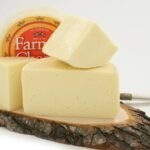Named after the majestic Bulgarian mountain where it originated, Vitosha-Kashkaval is a sublime culinary triumph borne from humble peasant beginnings. With its rich mouthfeel, appealing color, and complex layers of taste, it’s no wonder why this dairy gem has been a Bulgarian staple for centuries, and people around the world now savor its unique tang.
Kashkaval’s rich yellow color is a visual feast, signifying a maturation process that has been honed over generations. The cheese is semi-hard, with a texture that delicately hovers between creamy and crumbly, a delightful contradiction in terms. Making up for its relatively melting exterior, the cheese’s aroma is robust and assertive, hinting of the wild pastures of its origin. Vitosha-Kashkaval exhibits a hint of spiciness mingled perfectly with a slight sourness; its nutty overtones register subtly on the palate. It holds a smooth consistency, and as it melts in the mouth, it releases a collage of flavors that are marked by their harmony rather than any one dominant note.
What sets Kashkaval Vitosha apart from other cheeses around the world is more than its sensory appeal; the traditional crafting methods contribute significantly to its distinct identity. This artisanal cheese involves sheep’s milk curdled via the addition of microbial rennet. Unlike commercial cheeses, which prioritize efficiency over slow craftsmanship, the production of Kashkaval Vitosha prioritizes quality and traditional methods. The sheep’s milk, specifically chosen, contributes a distinctive richness and complex flavor profile to the cheese. The cheese undergoes a process of maturation that delights artisans with changes in taste and texture as it matures. It can be enjoyed at various stages, from the slightly salty and soft fresh cheese to the rich, full-bodied mature variant.
- The ripening process lasts from 2 to 6 months, significantly impacting the cheese’s flavor profile.
- The cheese is often smoked or baked as part of the preparation, adding an extra layer of complexity to its flavors.
- Its versatile nature makes it perfect for a variety of culinary applications, from salads to savory pastries, and it’s traditionally paired with rich, heavy Bulgarian wines.
In essence, the sophisticated Vitosha-Kashkaval cheese effortlessly marries tradition with striking sensory appeal. Rooted in the rustic pastures of Bulgaria, its complexities unfurl gently with each nibble, taking the discerning palate on a remarkable journey that defies easy categorization.
The Allure of Kashkaval Vitosha: Ingredients, Properties, and Varieties
Kashkaval Vitosha, a glorious product of Bulgaria, is a semi-hard yellow cheese that bears a distinct and complex flavor profile. Made primarily from sheep’s milk, occasionally blended with cow’s milk, Kashkaval Vitosha is characterized by its yellowish hue, smooth-ridged rind, and dense, aromatic paste. The cheese is named after Vitosha, a mountain near Sofia, Bulgaria, embodying both a rich tradition and robust geographical implications in its craftsmanship.
The grandeur of Kashkaval Vitosha begins with its ingredients. By and large, the cheese incorporates milk obtained from free-grazing sheep nesting within the expansive pastures of the Bulgarian highlands. Here, the livestock thrives on a diverse array of grass, herbs, and flowers, which contributes to the richly nuanced flavor of their milk. On occasion, artisan producers may also employ cow’s milk in the mix. The milk proteins are then coagulated using rennet, culminating in a firm curd that undergoes a meticulous aging process. This bearing imparts a subtly tangy, slightly sweet, and notably creamy taste complementing a persistent, buttery mouthfeel.
Kashkaval Vitosha boasts diverse forms and variants, enhancing its gastronomic appeal. They include:
- Young Kashkaval: Aged for approximately 60 days, it possesses a tenuous tanginess and soft, pliant texture.
- Matured Kashkaval: This variety ages upwards of 6 months and develops a potent, sharp flavor with a denser and crumblier consistency.
- Smoked Kashkaval: This version is lightly smoked over natural woods, adding a distinct smoky aroma and flavor to the cheese’s profil.
In conclusion, Kashkaval Vitosha is an exceptional cheese boasting a unique blend of ingredients and a myriad of sensory nuances. Its variants offer a captivating journey for the taste buds, carving an epicurean identity that transcends culinary boundaries and brings to your plate a taste of the Bulgarian highlands.
The Origin and Production of Kashkaval Vitosha
Kashkaval Vitosha is a popular Bulgarian cheese known for its rich flavor and aromatic qualities. It is specifically produced in the region surrounding the Vitosha Mountain, located in the southwestern part of Bulgaria. The Vitosha Mountain is one of the most significant symbols of Bulgaria and is a popular tourist destination.
Bulgaria, located in Southeastern Europe, is known for its long-standing tradition of cheese-making. The country has a favorable climate, fertile soil, and a rich agricultural industry, making it an ideal environment for the production of high-quality dairy products.
Kashkaval Vitosha is made from cow’s milk and has a semi-hard texture. The cheese is typically aged for a few months, allowing it to develop its distinct flavor profile. It has a pale yellow color with a smooth and firm texture. The cheese has a rich, salty taste, and its aroma is described as slightly nutty and buttery.
Production Process
The production of Kashkaval Vitosha involves several meticulous steps to ensure its quality and distinct characteristics. Here is an overview of the production process:
- Collection of Milk: Fresh cow’s milk is collected from local dairy farms surrounding the Vitosha Mountain. The milk is carefully selected to ensure its purity and freshness.
- Curd Formation: The milk is heated and rennet is added to facilitate curd formation. The curds are then cut into small pieces to separate the whey.
- Draining: The curds are gently transferred to molds where they are allowed to drain for a specified period. This helps in removing excess whey and giving the cheese its desired texture.
- Aging: After draining, the cheese is typically salted and left to age for a few months. During this time, the cheese develops its characteristic flavor and aroma.
- Packaging: Once aging is complete, the Kashkaval Vitosha cheese is carefully packaged and prepared for distribution to local markets, as well as international cheese enthusiasts who appreciate its quality.
Kashkaval Vitosha can be enjoyed on its own, sliced for sandwiches, melted on top of baked dishes, or grated over pasta for added flavor. Its versatility and unique taste make it a beloved cheese not only in Bulgaria but also among cheese connoisseurs around the world.
Discover the Culinary Delights of Kashkaval Vitosha Cheeses
Originating from the picturesque landscapes of Bulgaria, Kashkaval Vitosha cheese is a semi-hard, yellow cheese, lauded worldwide for its distinctive texture and piquant flavor. The process of making Kashkaval Vitosha rests on an age-old recipe that curbs the acidity in the cow’s milk, resulting in its signature tangy, slightly salty taste that is mildly reminiscent of Italian Provolone. This beautiful cheese with its creamy, flexible texture is suitable for grating, melting, and most interestingly, it fosters an exclusive gastronomic experience in numerous traditional Bulgarian and international dishes. Here, we delve into two distinctive recipes incorporating the marvelous Kashkaval Vitosha.
1. Traditional Bulgarian Kashkaval Pane (Fried Kashkaval)
With humble ingredients and a simple procedure, this dish showcases the fine characteristics of Kashkaval Vitosha.
Ingredients: – 200g of Kashkaval Vitosha – 1 cup of plain flour – 2 eggs – 2 cups of bread crumbs – Sunflower or olive oil for frying
The cheese is cut into rectangles, then successively dipped in flour, whisked eggs, and bread crumbs before being fried until golden. The result is a deliciously crispy exterior encasing the melted, pungent Kashkaval Vitosha – a tantalizing contrast of textures that will transport your taste buds straight to the heart of Bulgaria.
2. Kashkavalka (Bulgarian Ham and Cheese Bread)
A classic Bulgarian comfort food dish, ‘Kashkavalka’, is an appetizing encapsulation of the tangy Kashkaval Vitosha within a savory bread casing.
Ingredients: – 500g bread dough – 100g of ham, finely chopped – 200g of Kashkaval Vitosha, grated – 1 egg, beaten
The bread dough is rolled out and filled with layers of fine ham and grated Kashkaval Vitosha. It’s then folded over and sealed before baking until the crust turns a luscious golden brown. The plush bread plays perfectly against the mellow spice of the ham, while the melted Kashkaval Vitosha adds a heady robustness to this delightful dish.
Unfolding the Gastronomic Dynamics of Matching Wines and Dishes with Kashkaval Vitosha Cheese
Kashkaval Vitosha, the Bulgarian treasure of sheep’s milk cheese, holds an indelibly robust, mildly spicy, and slightly salty flavor profile. The uniqueness of its richly layered taste makes it an ideal entity for pairing with an array of wines and cuisines. Moreover, its semi-hard texture further augments its culinary potential, bridging flavors with unsurpassed complexity and depth. Endowing the dishes with a remarkable dynamic, the versatility of the Kashkaval Vitosha is bound to impress the most discerning cheese enthusiasts.
When it comes to wine pairings, the dietary component that heavily influences the match is the glycerol-rich style of the cheese. Kashkaval Vitosha, with its characteristic piquancy, can be seamlessly paired with medium-to-full bodied white wines and lighter red wines. Wines such as a crisp Pinot Grigio, a complex and subtly oaked Chardonnay, or a refreshingly fruity Beaujolais complements the tang of the Kashkaval Vitosha without overpowering it. Specifically, the perceived salinity of the cheese intermingles with the acidity and fruit-forward notes in these wines, creating a balanced culinary experience that is both intriguing and satisfying. Additionally, the nuanced herbaceous notes in certain Tempranillo or Aglianico wines can harmoniously marry the semi-dry peculiarity of the Kashkaval Vitosha.
As far as food pairing is concerned, Kashkaval Vitosha’s firm yet yielding texture makes it a desirable candidate for grilling and melting. Its readily receptive character allows it to imbibe the flavors of the accompanying ingredients, fostering an elevated gastronomic experience. Some popular pairings are:
- Grilled Veggie Skewers: The mildly piquant Kashkaval Vitosha can enhance the natural sweetness of grilled vegetables, creating a delectably balanced dish.
- Traditional Bulgarian Banitsa: Incorporating Kashkaval Vitosha into the classic, flaky pastry gives it a sumptuously cheesy twist.
- Pungent Garlic Bread: When melted onto a slice of freshly baked garlic bread, the Kashkaval Vitosha adds a delightful creaminess to the crunchy serenade.
Appreciating and understanding the complexity of the Kashkaval Vitosha can truly enhance the joy of food and wine pairing, leading to delightful, unforgettable gastronomic experiences. It’s a testament to the culinary versatility of exquisite cheese like Kashkaval Vitosha to command the center stage, whether on the dining table or in the company of a well-selected bottle of wine.
Exploring Similar Cheeses to Kashkaval Vitosha
Kashkaval Vitosha is a type of cheese with Bulgarian origins known for its distinct flavor and versatility. When seeking similar cheeses to Kashkaval Vitosha, you’ll discover several options that share certain characteristics with this beloved cheese. Whether you’re looking for a substitute or simply want to expand your cheese repertoire, exploring these similar cheeses can offer a delightful culinary exploration.
1. Kashkaval Sirenje: Hailing from Bulgaria like Kashkaval Vitosha, Kashkaval Sirenje is another popular semi-hard cheese made from cow’s milk. It boasts a smooth and creamy texture, making it a versatile ingredient in various dishes. Kashkaval Sirenje offers a slightly milder flavor compared to Kashkaval Vitosha, but it still delivers a rich and buttery taste that cheese enthusiasts appreciate.
2. Manchego: Originating from Spain, Manchego is a well-known cheese made from sheep’s milk. It shares similarities with Kashkaval Vitosha, particularly in terms of texture and firmness. Manchego has a slightly tangy and nutty flavor, which intensifies with age. This cheese is often enjoyed on its own, paired with meats and fruits, or grated into various dishes.
3. Pecorino Romano: Another cheese crafted from sheep’s milk, Pecorino Romano has Italian origins and a unique flavor profile. This hard cheese boasts a sharp, salty, and piquant taste that differs from the milder Kashkaval Vitosha. Pecorino Romano is an excellent option for grating over pasta dishes, soups, and salads, adding a robust and savory touch to your meals.
4. Gouda: This semi-hard cheese from the Netherlands is well-known for its buttery and slightly sweet flavor. Gouda shares some similarities in texture with Kashkaval Vitosha but has a slightly milder taste. It is often enjoyed on cheeseboards, melted into sandwiches or gratins, or used as an ingredient in warm, comforting dishes.
- Kashkaval Vitosha is a Bulgarian semi-hard cheese.
- It has a rich and buttery taste.
- Kashkaval Sirenje is a similar Bulgarian cheese with a slightly milder flavor.
- Manchego, a Spanish cheese, shares texture similarities with Kashkaval Vitosha.
- Pecorino Romano, an Italian cheese, offers a sharp and salty taste.
- Gouda, from the Netherlands, has a buttery and slightly sweet flavor.



